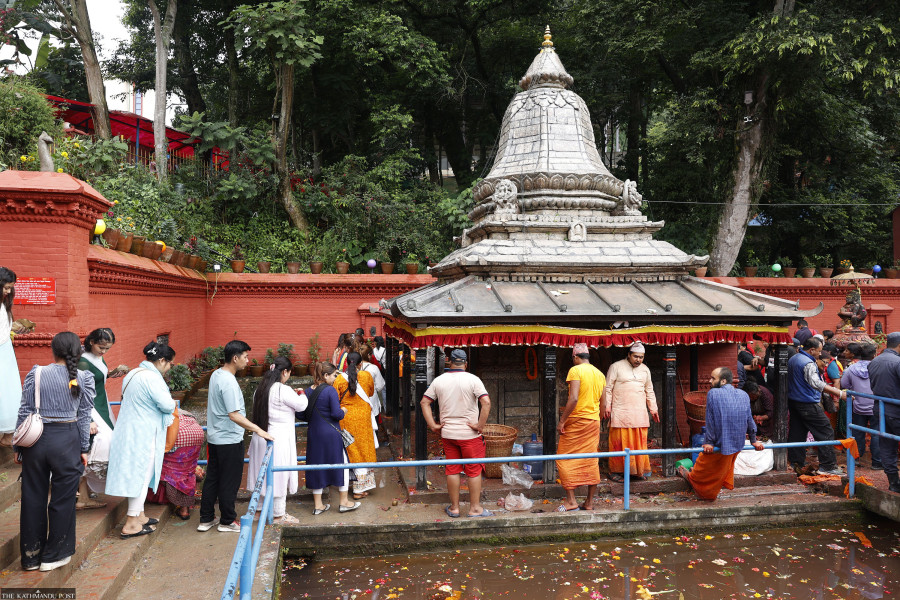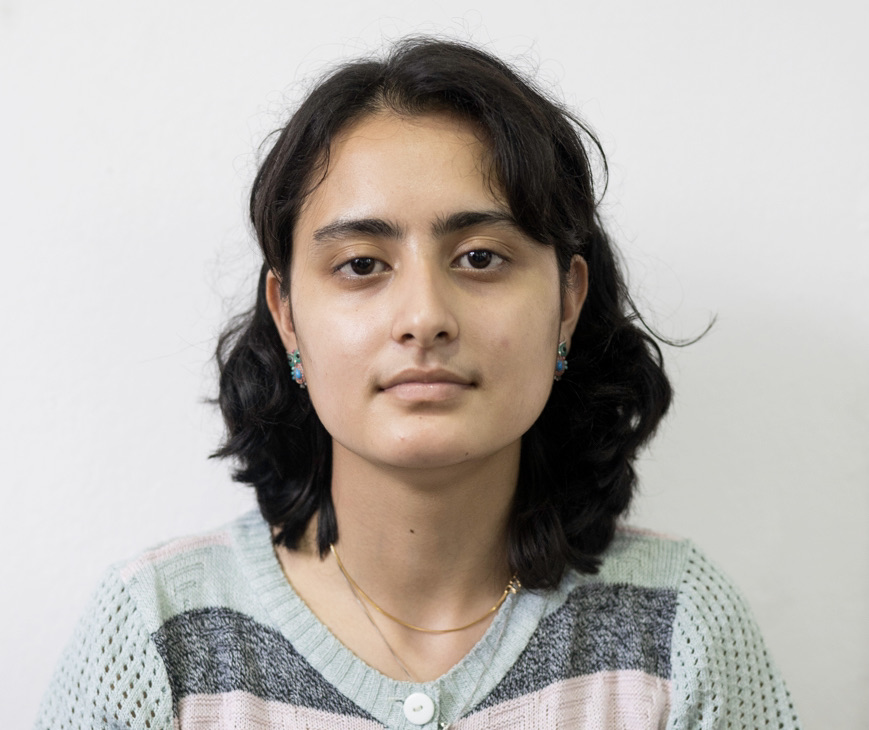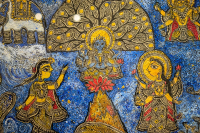Culture & Lifestyle
Machchhenarayan Mela draws devotees from near and far
Thousands of devotees make their way to the Machchhenarayan temple to honour Matsya, one of the ten incarnations of Lord Vishnu.
Urza Acharya
Last Saturday, Machchhegaun, Chandragiri-9, near Kirtipur, saw an overwhelming number of visitors. The small town which hosts the Machchhenarayan Temple—is often overshadowed by Kirtipur’s cultural glories like the Bagh Bhairav and Uma Maheshwar. But during the Purushottam Maas (a special extra month according to the ancient Hindu lunar calendar)—this year it is July 18 to August 16—Machchhegaun takes centre stage, inviting not just local Newa devotees but others who travel far and wide, some even from India and Bangladesh.
The entire affair is known as the Machchhenarayan Mela, which takes place only two times every five years. The overwhelming crowd brave the heat and stand in lines—that, at times, stretch almost a kilometre—for two things: to receive blessings from the Machchhenarayan Temple and swim in the adjacent pond. This, it is believed, will wash away the gravest of sins as well as grant the grandest of wishes.
In legends from the Purans, we learn that those who wish for an appearance from God must work for it. Well, something similar happened in real life too. Afraid that I’d be stuck inside my motor because of the influx of large buses coming down from the temple, I decided to park on a secluded road a few kilometres below. It was noon—and the sun, perhaps a little too generously, was enveloping our bodies (my friend Shristy was accompanying me) with its infrareds. Albeit, we walked up the hill, amazed by the movement of people—nothing short of what we see during Shiva Ratri in Gaushala.
In front of the buses that sped downhill just a little too brashly, one could see kitschy flex banners hung haphazardly—plastered with pixelated images of Hindu gods and texts alluding to the Machchhenarayan Mela.

After a 20-25 minutes walk, we were greeted with a large makeshift gate—one sponsored by a local beer company—that marked the final stretch to the temple. Either side of the street had residential houses—clearly hinting that the temple, except for during the mela, wasn’t prone to many visitors.
Whenever there was some space—in a move that would render Kathmandu’s mayor, Mr Balen, vehemently angered—temporary shops were spread about—selling anything from cheap toys, bedsheets, and woodcrafts to everyday modern clothes.
Eateries were aplenty, serving food we associate with temple visits—samosas, sel-rotis, kheer, pakoras, milk tea (somehow always too sweet) and the like. But the star of the show was malpuwa. A sweet pancake-like dish, it adored the centre-most tray in all the shops. This temporary fame for this otherwise side-lined tea snack was because of the belief that presenting malpuwa to the Matsya god can help accelerate the manifestation of one’s wishes.
The malpuwa-loving god, Matsya, is the first incarnation of Lord Vishnu, one of the OG gods (in GenZ terminology), alongside Shiva and Brahma. One story (among many) goes: Once, there was a demon king named Hiranyaksha who performed severe penance to please Brahma. Pleased with his devotion, Brahma appears before him and grants him a boon. Hiranyaksha uses this boon to become extremely powerful and begins to wreak havoc on the Earth and the heavens.
One day, Hiranyaksha descends into the depths of the ocean and captures the Earth (personified as the goddess Bhudevi) and hides her at the bottom of the cosmic ocean. This disrupts the universe’s balance and causes great distress among the gods and beings on Earth.
To restore said balance, Vishnu incarnates as Matsya, a fish. Matsya encounters King Manu, a pious ruler who puts him in a pond—after the fish reveals his fears of being eaten by other big fish.

From a tiny little pisces, Matsya grows larger and larger, eventually becoming so massive that even the ocean can’t contain him. To thank Manu for his kindness, Matsya guides Manu’s boat to safety as the waters rise, eventually leading it to the highest mountain peak. As the floodwaters recede, Matsya reveals his divine form to Manu. This is the Hindu take on the ‘great floods’ myth present in most cultures and religions, like the tale of Noah’s Ark in the Bible.
According to Achyut Adhikari, the ward chairman and head of the organising committee of the Machchhenarayan Mela, locals believe that the pond inside the temple premises is where King Manu put Matsya to protect him. “That is why people wish to dip in the pond; they consider it to be divine water graced by Lord Vishnu himself,” he says.
The Machchhenarayn temple itself is relatively small. A chaitya-style facade—made of white stones with a gajur on top—decorates its roof. The small walkway to the temple was constantly treaded by footsteps of devotees, all rushing to receive tika from the residing priests.
Adjacent to the temple is the lower pond, which is where devotees swim. As I looked over, I saw men and women dipping themselves in and out of the water while a kid floated nonchalantly with a swimming tube.
One of the visitors that day, Savitri Shrestha from Bagbazaar, has been coming to the festival since childhood. “Our family never misses the mela; it’s become a part of our tradition,” she says.

To manage large crowds, a committee called the ‘Purushottam Maas Mela Byabasthapan Samiti’ has been established. Locals like Suman Manandhar, a volunteer I met near the entry point to the temple, ensure that no conflicts or chaos occur in the sacred site. “The important thing is to ensure everyone gets a turn,” he says.
For the locals, he claims, the Machchhenarayan Mela is as precious as big festivals like Dashain or Tihar, as it brings their town into the limelight.
Moreover, many of their local traditions have become intertwined with the festival. Bidhan Shrestha, another resident and a Lakhe dancer himself, reveals that as the festival falls within the cropping season—Lakhe dances have become part of the celebration. “The Lakhe dance serves two purposes: to honour Matsya and scare the Rakshyas that might ruin the crops,” he says.

It is evident that during the Purushottam month, the Machchhenarayan temple—which otherwise doesn’t get many visitors despite being open throughout the year—transforms into an entity of its own, powerful and sacred enough to gather hundreds of thousands of visitors. There is a sort of daze in the air—heightened by bhajans and the buzzing of unintelligible voices.
As I scanned the moving faces, I realised that it was a festival for all—sadhus clad in orange waiting for some dakshina to fall on their way, devout followers carrying taparis filled with freshly plucked flowers and malpuwa, vendors setting up shop to make some extra cash from those who came solely for the Facebook pictures.
But most importantly, Macchenarayan Mela is the most anticipated gathering for the residents of Macchhegaun itself. “Residents perform their duty sincerely from eight in the morning to nine at night,” says Adhikari. “It is our greatest honour to have such a sacred temple in our community.”
The mela will continue in Machchhegaun, Chandragiri, till August 16.




 6.73°C Kathmandu
6.73°C Kathmandu















